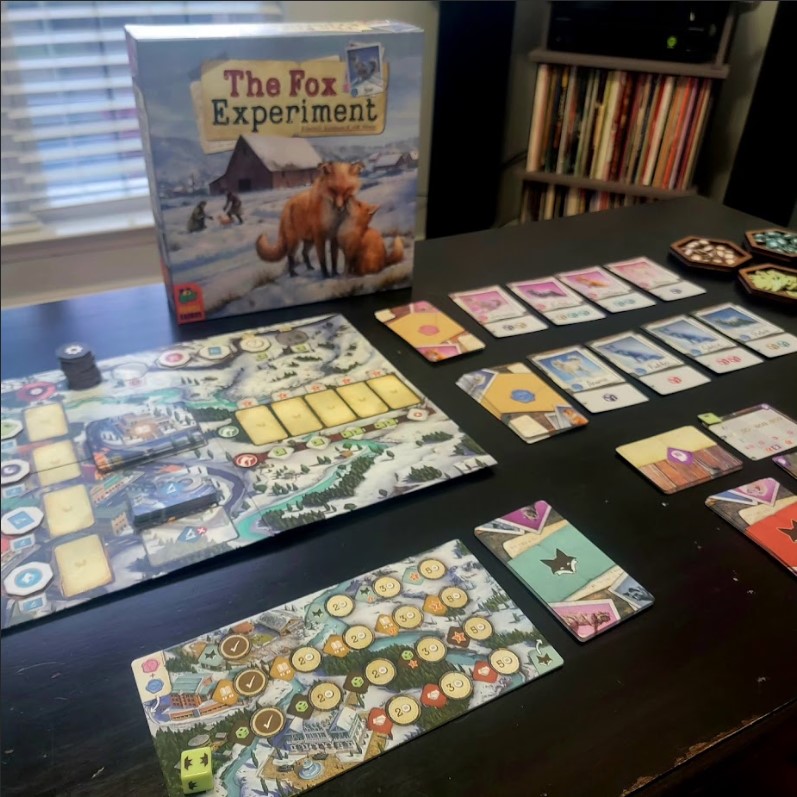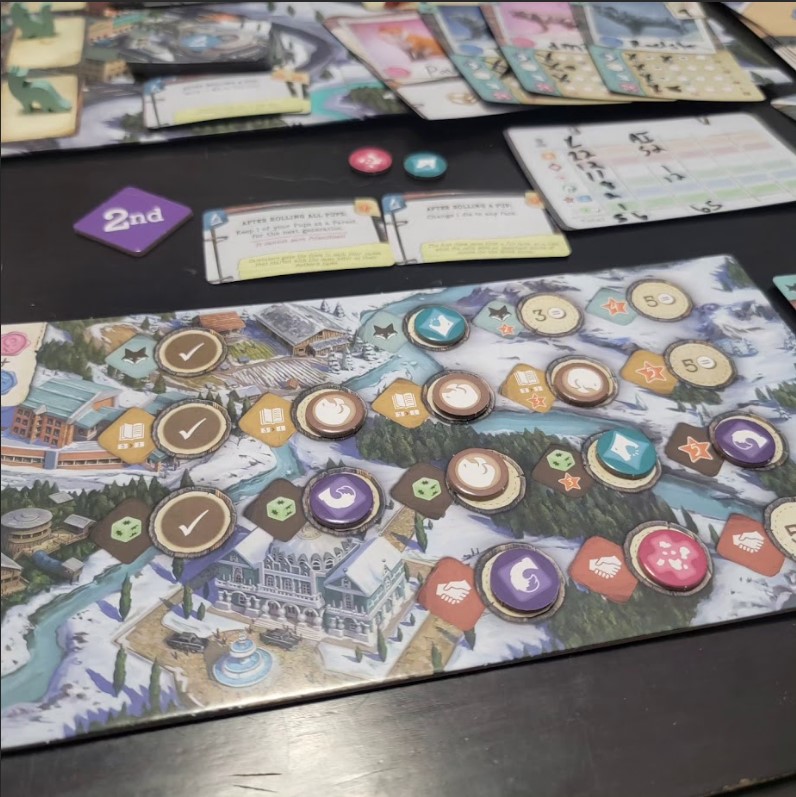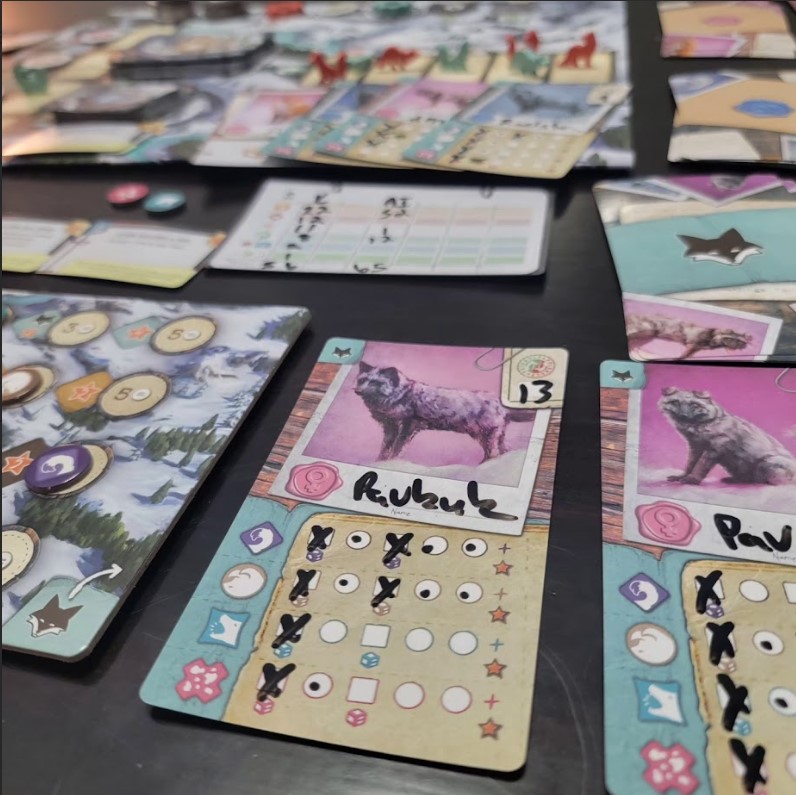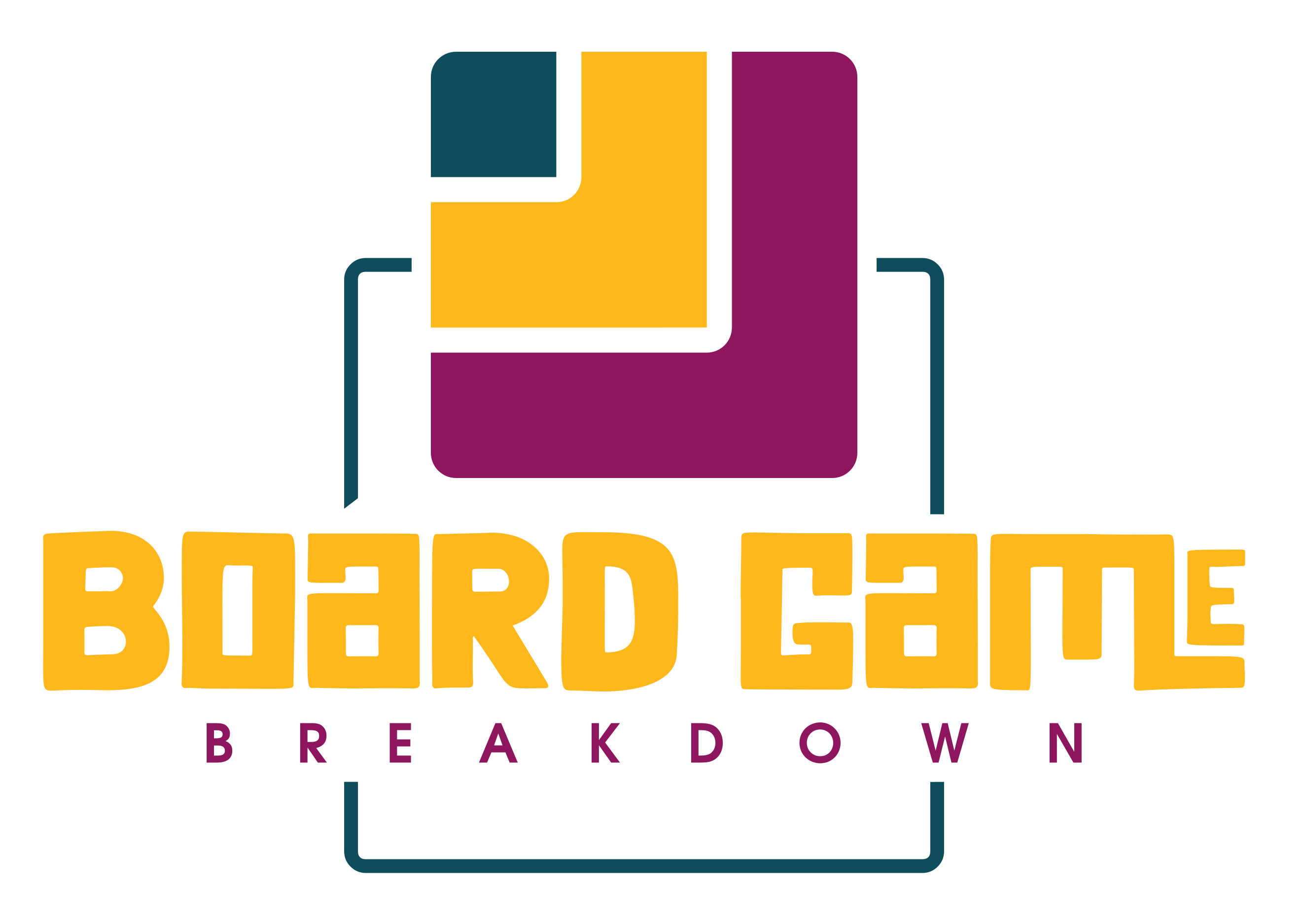
Name: The Fox Experiment
Year of Release: 2023
Player Count: 1 – 4
Playing Time: 60 Minutes
Designer: Elizabeth Hargrave & Jeff Fraser
Publisher: Pandasaurus Games
Primary Mechanisms: Dice Rolling, Open Drafting, End-Game Bonuses, Roll-and-Write
Weight (According to BGG.com): 2.54
Overview
Being successful with your early (or even debut) creative endeavors is obviously something that a lot of people hope for but it can certainly put undue pressure on later works. I typically see this the most in the music industry. For example, most critics and listeners are never going to choose to listen to Strangers to Ourselves, released by the band Modest Mouse in 2015, over the seminal Lonesome Crowded West, released in 1997 and the band’s second proper release. Nor will they choose the 2022 release, Asphalt Meadows, by Death Cab for Cutie over The Photo Album, released 20 years earlier.
Now for the record, neither one of those later releases stand up to the earlier albums, so I’m not suggesting that, but I am suggesting that the greatness of the earlier albums is always going to cast a heavy shadow over any work that comes after it. As a board gamer, I think this same phenomenon can happen to designers, and possibly no more so than in Elizabeth Hargraves’ case.
If you don’t recognize her name, you probably at least recognize the name of her most well-known game, Wingspan. This game has transcended the board gaming culture, having articles written about it in major newspapers, and being featured in almost every big box store around. But does the fame of Wingspan negatively impact all of Hargraves’ future work or does the love people have for Wingspan end up bleeding over to her other creations?
Honestly, it’s probably a little of both depending on who you’re talking to. And while I can’t answer this question for everyone, I can look at The Fox Experiment and give you details of what you’ll get with this game and my most un-Wingspan-biased thoughts on it.
Rulebook & Components

I’ve sure I’ve said it here before but I absolutely adore an impressive rulebook. One that begs me to simply read through the whole thing before even thinking about glancing at the components. The Fox Experiment comes with a rulebook that fits this bill perfectly. Players will get 36 pages of detailed explanation and beautiful pictures illustrating the ins-and-outs of the game. Yes, 36 pages seems like quite a lot for a game barely peaking over the 2.5 weight threshold, but some of the length is due to the fact that the 3-and-4 player game has a different set of rules from the 2-player game and then both of these differ greatly from the 1-player game. Regardless of which variant you’re playing, the rulebook does a great job of walking you through the course of the game.
When it comes to the components, the first thing you’ll probably notice is the slew of dice that you receive. The dice come in five colors but unlike your normal run-of-the-mill dice, these come printed with a symbol on each side; some sides containing a full symbol, others with half-symbols, and others with a combination of these. We’ll get more into what these symbols mean when we get to the gameplay section.
Matching the color of the dice are a multitude of Trait Tokens. These represent the different traits players will be attempting to breed in their foxes. Speaking of foxes, players will be gifted with ten fox meeples, in four different colors, to use throughout the game. I’m really a fan of the designers not just settling for a single meeple shape but a variety of different fox shapes and poses. It’s not a huge thing, but sometimes, it’s the small details that matter. Players will also be given a Gear Token in their chosen color which will in one of the actions from the first phase of the game. Rounding out the individual player components, each color has a stack of dry-erase cards to be used when breeding foxes. These cards contain a picture of a fox pup, a grid to be filled in with the traits bred into the animal, and even a space for players to use to name their newly bred pet.
Other components include a two-sided board allowing players to use one side for one-to-four players and the other side to accommodate the expansion which increases player count to five and six players. There are additional decks of cards that will be used throughout the game, including Study Cards, Research Cards, and Patron Cards. While all of the components are nice visually, the quality is a little lacking for my taste. First off, my board is already separating at one of the points where it folds and this is only after a handful of plays. Second off, there is an actual printing mistake on one of the Parent Fox Cards. There is a deck of female fox parents and a deck of male fox parents, with each card including one to three dice symbols on it. The instructions plainly state that between all of the Parent Fox Cards, all traits will be evenly distributed but some intrepid user on BoardGameGeek noticed otherwise. One card only has a purple dice printed on it when it should really have both a purple and a brown die. Elizabeth Hargreaves even weighed in on the BGG forum, confirming that this was a printing error. From what I’ve read, these issues are probably more due to Pandasaurus and their decline in quality control as others have seen in various games. While these don’t impact the game too greatly, it should still be noted for potential buyers.
Setup
Setting up Fox Experiment isn’t that much of a chore, and should only take a few minutes, especially if you separated all of the discarded cards in your previous game. I’d rather dedicate more of time here in this written review to how the game plays, but you can check out our long form video here for full details on setting the game up.
Gameplay
The Fox Experiment does play slightly different depending on player count so I will concentrate on the most straight forward version, the three or four player game, but skip to the Additional Comments section for a few thoughts on how the one and two player game works.
The game is going to be played over five rounds, with each round consisting of four phases. Some of these phases will have players taking turns while others have all players doing their thing simultaneously. Yes, the simultaneous sections can feel like “multiplayer solitaire” but I’ve gone on the record before as having no problems with those types of games, so it doesn’t affect me in the slightest. But I’m warning all of you who do find these types of games annoying, the majority of phases are going to be in this vein.
The first phase is called the Selection phase and it will be the one phase that players take turns in. Each player will take three actions during this phase. These actions can be done in any order but each action can only be done one. The three actions include:
- Taking a Female Parent Fox Card
- Taking a Male Parent Fox Card
- Selecting a Turn Order space
When doing one of the first two actions, players will be selecting cards from the Kennel created during setup. The Kennel is a row of males and females, both consisting of a number of cards equal to the number of players plus one. As I mentioned before, the parent cards are each printed with a selection of die icons in differing colors, impacting which traits are going to be bred into your fox pup. Card selection, especially in the early game, are going to be mostly driven by the Study Card players chose to keep during setup. These cards essentially list certain traits that their owner will want to breed in their fox in order to score extra Victory Points at game end.
With only having four traits in each fox, these Study Cards can greatly overlap, causing players to target the same parent foxes so there are definite advantages to going earlier in each round. This is where the third action (selecting a Turn Order space) comes in. If a player chooses to take this action, they will take their Gear Token and place it in one of the turn spaces at the top of the board. These spaces are going to help to re-order who goes first in the next round, with the furthest left space taken awarding 1st turn, 2nd place going to the next left-most Gear, etc. Each of these spaces, except the left-most one also has a bonus token on it which allows the player to get extra Research Cards or additional Trait Tokens. So, the trade-off here is if a player wants to secure an early choice in the next turn, they can be the first to place their Gear marker on the left most space but won’t get any additional bonuses that round. Or players can take a chance and grab a space more to the right, gaining more tokens or cards, but running the risk of having to go last in the next round, which might significantly dampen their ability to pick the Parent Cards they need. This first phase is a fun little bit of push-your-luck and hoping that you can get both the Parent Cards and the Turn Order you want before your opponents do.

Once this phase is done, the Breeding phase starts which means there is about to be a whole hell of a lot of dice rolling around, or at least there will be in the later rounds of the game. Unlike the first phase, this second phase will be completed simultaneously by all breeders. Players will look at the dice printed on the two parent cards and take those dice from the pool. They will also include the green Friendly Dice (from setup) and any others they might have gotten as upgrades throughout the game, and then roll all these dice. Players will then want to organize the dice in rows of like symbols, trying to create the largest amount of whole symbols. Players complete this task by using a die with an already completed symbol on it, or by combining two halves of the same symbol to create a finished one. As mentioned earlier, the Friendly Dice act as wilds so these come in handy in this phase to help players to focus on the traits that their individual Study Cards call for.
After players have organized their dice in the order they want, they will take their dry-erase markers and mark the spaces on their Fox Child Card, equal to how many of each trait symbol they created, with partial symbols being ignored. Each of the boxes are marked with an “X” and each circle space is marked with a filled-in dot. For example, I roll a collection of three purple die, one red die, and one green die. The purple die give me two complete symbols and a half. The red die is a half symbol and the green die is a half symbol. I could couple the green die with the purple and end the round with three purple symbols and zero red symbols. Conversely, I could pair the red symbol with the green symbol and end the round with two purple symbols and a single red symbol. If I chose this second option, on my card I would mark the left-most box on the purple row with an “X” and then fill in the next spot, which is a circle. On the red row, I would simply mark an “X” in the first box.
Once complete, the player will count up how many spots they were able to mark in all and place this number in the top right corner of the card which is how the Friendliness Rating is calculated for each fox. If players have unlocked the ability to breed multiple foxes a round, they will roll and fully breed one fox card, and then re-roll all dice and repeat the process with the second card, repeating again if they are breeding more than two foxes. As you can tell, each round will bring on more dice, which will allow players to gain even more trait symbols, which allow them breed even friendlier foxes.
Lastly, the Breeding phase wraps up with each player naming their foxes and writing said name on the card. Sure, this has absolutely no bearing on the game, but it is a fun time, coming up with names and laughing with your fellow breeders. Sometimes, I even like going with a theme (such as naming all my foxes after Star Wars characters) to drive my naming conventions.

After the naming ceremonies are over, it is time to move to another simultaneous phase, called the Research Phase. The majority of this phase is going to revolve around your individual Study Card and player boards. This will be the time that breeders will check to see if their newly bred pup ticks off the appropriate traits to match the next level of the Study Card. If so, the player will place a fox meeple there, showing that they’ve achieved this level and will score those points at the end of the game. As a side note, each fox can only achieve one study level on one study card each round.
Players will also take a circular Trait Token for each of the filled-in dots on the pup card. The tokens will be added to any they’ve collected in previous rounds and then can be spent on the individual boards to unlock new abilities. The abilities include things such as acquiring more Friendly Dice, opening the ability to breed multiple foxes in a round, or drawing more Study Cards.
The last phase is the Administration Phase and is used to re-fill the board and get it ready for the next round. One important part of this phase is that the player with the “friendliest” (meaning the highest number in the right-hand corner) fox places one of their meeples in that specific spot on the board. This will reward victory points at the end of the game, even upping the amount of points you’ll score as the rounds progress. Losers in this category don’t score points but do get a consolation prize so they don’t leave empty handed.
One of the most intriguing parts of this phase is that the holes in the Kennel, made by the original parent cards being picked, will be re-filled with the pups that were just bred! They probably won’t fill up all the holes, so then more Parent Cards are drawn from the deck to refill these rows. This is how future pups will typically have more and more traits bred in them, but players should watch out, because if they select a male and female from the same color (meaning the same breeder) they are hit with a penalty for “inbreeding.” This ensures that players don’t consistently draft their owns pups from previous rounds and encourages them to draft cards that others have bred.
This will also be when the turn order is re-constructed based on the placement of the Gear Tokens in the first phase. Once the Kennel is re-filled and the board is filled back up, the game is ready to progress to the next round. Play continues in this way for five rounds and then the game is over. Players will score points for their Study Cards, their Friendliness points, Patron Cards, and points collected on their player mats. For more on gameplay, please check out our full How to Play video here.
Additional Comments

I wanted to touch on the 2-player and solo version really quickly, because they both play a bit differently from the 3-and-4-player game. The 2-player game is the most similar but does include a third artificial player that takes actions in just the first phase. An Automa Deck is used to control their actions and they are basically there to block certain Parent Cards and Turn Order spaces each round. The artificial player is given a Study Card which helps drive which dice that it wants to collect. It also has a mechanism to add die to future cards, mimicking the act of moving pups into the Kennel to become parents. One of the players obviously has to handle the upkeep with the artificial player, but it doesn’t take a ton of time and the other player will have almost no impact to the way they go about playing the game.
Unlike the 2-player game, the solo game has a lot of upkeep. The same Automa Deck is used, but this time, the artificial player gets to actually breed foxes every round and with no actual player, that means the lone player is creating both their foxes and the artificial players. If you enjoy the act of creating pups, you might really love this but for me, it was more akin to filling in spreadsheets (which I do on a daily basis already) and took a lot of the fun out of the game. It isn’t horrible but it definitely is not the type of solo game I prefer.
Conclusion
The Fox Experiment has been a real hit with my wife and I. We like the combination of an interactive first phase and then simultaneous play in the other phases, as it helps the game move along at a quick pace. I also like that there are enough ways to mitigate bad rolls and I’ve never felt completely sunk by the roll of the dice. I’m glad that the designer didn’t just try to imitate her past successes and branched out to a whole new type of game though I do wish that the solo version was more fun to me personally.
Links
Rating
Ratings are based on 5 main criteria: rulebook, setup, components, art & graphic design, and gameplay. The first 4 criteria are rated 1 to 5 and the gameplay is rated 1 to 10. These scores culminate in an “overall satisfaction” score that is rated from 1 to 10. If the reviewed game has both a solo and multiplayer mode, I have assigned scores separately to give context to which mode we enjoy more.
As an Amazon Associate I earn from qualifying purchases.
Amazon: Amazon.com: The Fox Experiment Board Game – Breed and Evolve Your Foxes! Strategy Game, Fun Family Game for Kids and Adults, Ages 10+, 1-4 Players, 60 Minute Playtime, Made by Pandasaurus Games : Toys & Games
